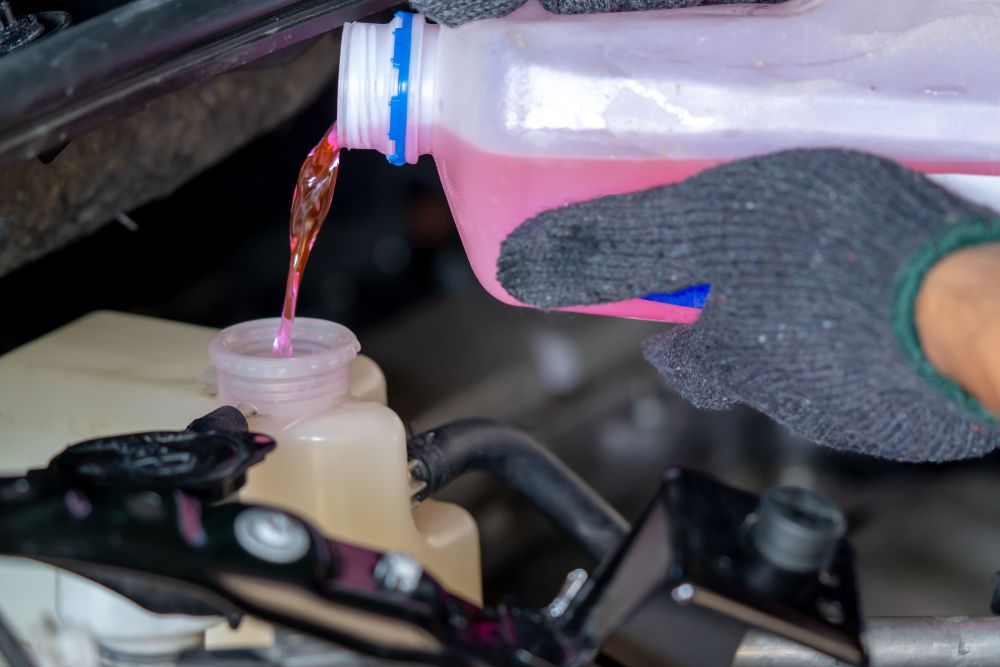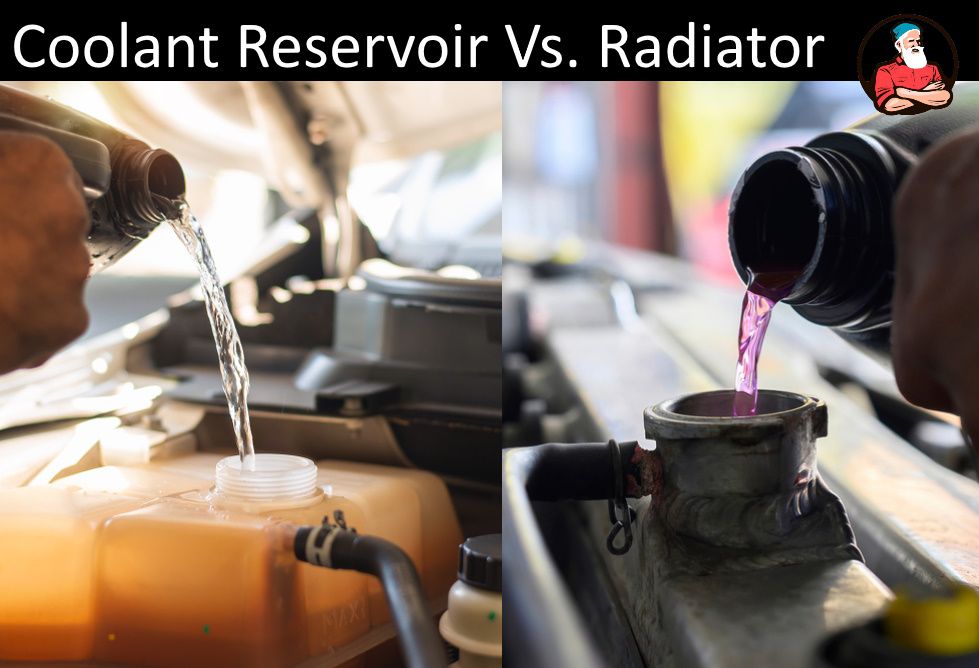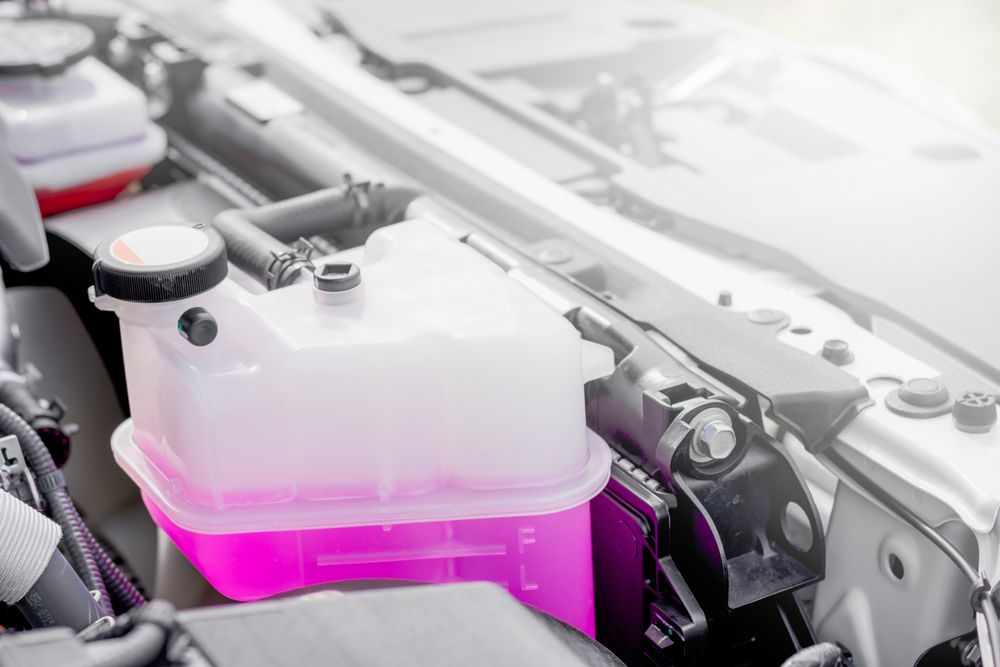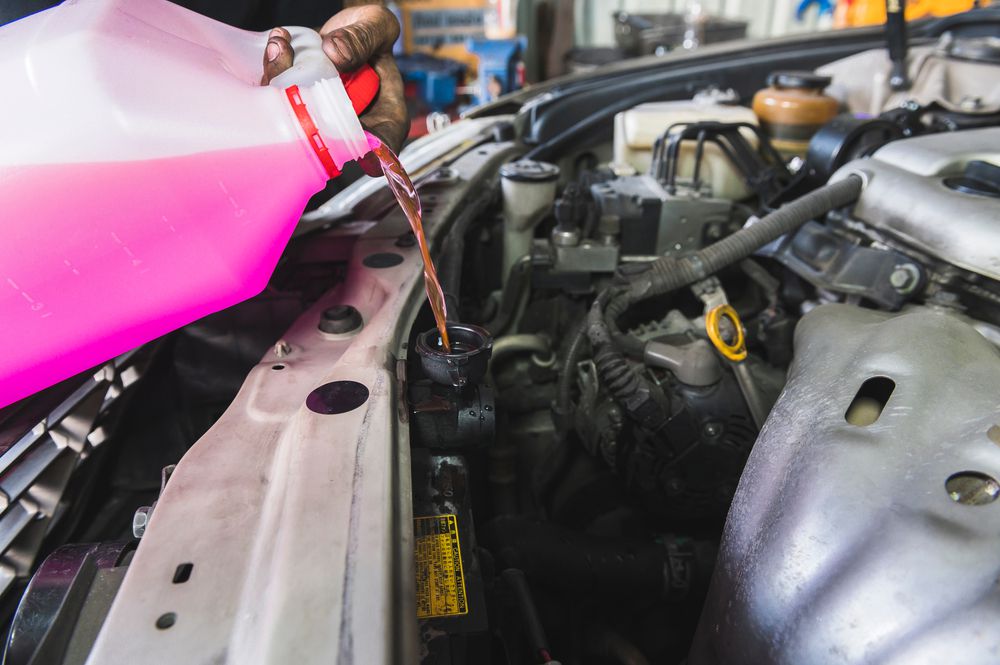If the coolant level in the coolant reservoir in your vehicle is low, you may be wondering if you should leave the car running when adding engine coolant (antifreeze).
Ideally, it would be best to wait until the car is off and cooled off before adding engine coolant, also known as antifreeze, to your vehicle's coolant reservoir.
However, the engine coolant reservoir has two levels, a hot and cold fill line, so you can add coolant to the reservoir fill line that matches the engine's temperature with the engine running.
You should not attempt to add coolant to the radiator while the car is running with a hot engine because it's not safe.
To learn more about the risks of adding coolant to a hot engine and how long to wait before and after adding coolant, keep reading.
We're diving into these topics and touching upon why you should never drive with low or no coolant.
 Adding coolant to a coolant reservoir
Adding coolant to a coolant reservoir
When To Add Coolant To Car
If your coolant level is low, you should add coolant as soon as possible to prevent engine damage. Coolant's critical purposes are keeping the vehicle's engine at a normal operating temperature and preventing engine corrosion.
The vehicle's cooling system basically consists of a radiator, radiator cap, water pump, thermostat, and engine coolant reservoir.
The engine's coolant, a mixture of alcohol and water, is pumped through the engine by the water pump.
Once the coolant reaches a specific temperature, the thermostat opens, allowing the engine coolant to be circulated through the radiator, where it is cooled by air.
Hot coolant expands so the cooling system can become pressurized. The radiator cap is what opens and closes depending on the system's pressure to expel and draw coolant from the coolant reservoir. This way, the radiator is always full.
So, because the cooling system is hot and under pressure while the engine is hot, we need to take extreme care regarding how we add coolant, lest we make a mistake and get severe burns.
Since adding coolant (antifreeze) to your vehicle involves components under the hood that get hot and dangerous to touch, you need to be careful when filling it.
Can You Add Coolant To A Warm Engine?
You can add new coolant to a warm engine if you mind the coolant level in the coolant reservoir.
There is usually a hot line and cold line on a coolant reservoir which shows where the coolant should be depending on the engine temperature.
When the engine is warm, you will want to add enough new coolant so that it reaches the top line on the coolant reservoir.
You should not attempt to add new coolant to your car's radiator while the engine is warm.
Most engines take a half-hour at least to cool down, but if yours is overheated, you may need to wait longer before it's safe to inspect (up to 2-3 hours).
 Coolant reservoir on the left vs. a radiator on the right.
Coolant reservoir on the left vs. a radiator on the right.
Risks Of Adding Coolant To a Warm/Hot Engine
There is a serious risk of serious burns if you try to add coolant to the radiator of a warm or hot engine.
When an engine is warm or hot, the vehicle's cooling system will be pressurized, apart from the coolant reservoir (overflow tank).
This means that if you open the radiator cap of a warm or hot engine, the hot coolant and steam in the system escape and burn you.
At the very least, some coolant may escape and make a mess on the ground.
The coolant cap on the overflow tank does not hold pressure, so you have zero risk if you open it.
Should The Car Be On When Adding Coolant?
The car can be on while adding coolant, but you must be very mindful of the car's engine temperature.
If you just recently turned the car and the engine is still cool, you can open the radiator cap without risk of getting burned or making a mess.
If the vehicle has been running for a significant amount of time, it is probably better to err on the safe side, turn the engine off, and let it cool off if you want to add coolant to the radiator.
In any case, you are safe to add coolant to the coolant reservoir.
 Clear plastic coolant reservoir with fill lines
Clear plastic coolant reservoir with fill lines
Where Does Coolant Go In A Car?
Many car owners wanting to refill coolant at home also wonder where do I put coolant in my car?
Typically you need to fill the vehicle's coolant reservoir, also called a coolant overflow tank.
The reservoir is usually a white or somewhat clear container connected to the radiator with some hose.
The reservoir usually has two lines: a cold fill line and a hot fill line. The hot fill line will be the top line, while the cold fill line will be the bottom.
The coolant level will change depending on the cooling system's temperature.
When the engine is hot, the coolant expands; therefore, the coolant level should come up to the top fill line, while if the coolant is cold, the coolant level should be at the bottom line.
If the engine is hot and running when adding coolant, you need to add enough coolant to reach the top line; however, if the engine is cold, you will need enough coolant to reach the bottom line.
Can I Add Coolant Straight Into The Radiator?
In some cases, however, a vehicle may have a cooling system where you must add coolant directly into the radiator.
This will only be the case if your car doesn't have a traditional reservoir or overflow tank for antifreeze.
Otherwise, you might need to add coolant directly into the radiator if, for some reason, the reservoir is not working properly to send coolant to the radiator, usually because of a malfunctioning radiator cap.
 Adding coolant to radiator
Adding coolant to radiator
How To Add Coolant To A Radiator
- The best way to add coolant straight into the radiator is to start with a completely cool engine and fill the radiator with new coolant.
- Then, start the engine with the radiator cap off and let the coolant be pumped through the engine, continuing to refill as necessary. This allows any air bubbles to escape.
- You can monitor the cooling system temperature by checking the vehicle's temperature gauge.
- Once full, put on the radiator cap.
What To Do After Adding Coolant
After adding coolant, ensure you have correctly installed the reservoir cap and radiator cap.
After adding coolant, monitoring your vehicle's temperature gauge for any abnormalities is essential.
If you had to add coolant, it's important to know why you had to add coolant in the first place.
When an engine overheats, it can cause seals, hoses, and gaskets to leak, so it's a good idea to carefully inspect the engine bay and the ground for any leaks.
Check your engine oil for a foamy or milky substance which is a symptom of an internal coolant leak.
How Long Should I Wait To Start Car After Adding Coolant?
After adding coolant, you can start the vehicle as soon as you'd like.
How Long Can You Drive With Low Coolant Before Adding More?
Driving with a low coolant level should be kept to an absolute minimum. If you must, you can even add water in small amounts to get to the mechanic or home.
Whatever you do, don't overheat your engine. Overheating an engine can cause catastrophic damage that is expensive to fix. Making matters even worse, often, after fixing an overheated engine, it still won't run as good as before because of slight metal malformations.
If your engine is overheating, it is best to call a tow truck
You definitely want to avoid worst-case scenarios if possible, as they are quite costly to fix.
Repairing a damaged engine block alone costs $3,590 on average, which doesn't even account for the possibility of damage to associated parts.
Risks Of Running On Low Coolant
If you need to drive with a low coolant level, there are a few things you need to keep in mind.
An engine low on coolant is at extreme risk of overheating and suffering from damage.
You could completely blow an engine head gasket (this costs more than $1,000 to replace on average)
You could ruin your engine and require a total engine replacement (this costs around $4,000 on average).
Conclusion
Some people prefer to turn an engine off and let the engine cool before adding coolant, but it's unnecessary if you fill the coolant reservoir, not the radiator.
You can fill the vehicle's coolant reservoir while the engine is fully warmed up and running because the coolant reservoir is not under pressure.
However, you should not try to add coolant to the radiator while the engine is warmed up and running because there is a high risk of getting burned by steam and hot coolant.
References
https://www.jdpower.com
https://www.military.com
https://vehq.com
https://www.autozone.com
https://repairpal.com
https://www.firestonecompleteautocare.com